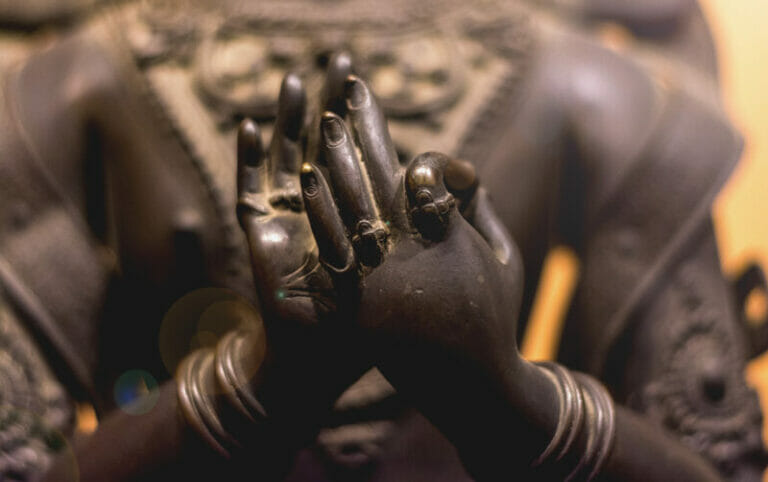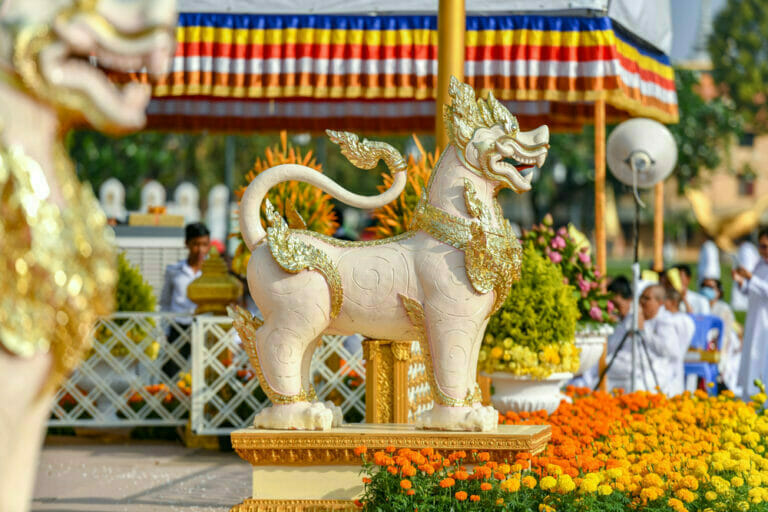Words to Describe Buddhism (The Fundamentals)
This article focuses on some of the most important words and phrases that are essential for understanding Buddhism.
According to Wikipedia, Buddhism is the world’s fourth largest religion with more than 520 million followers worldwide. However, a Buddhist has no religious sentiments that fit the profile of either a monotheistic or polytheistic worldview.
In many ways, this religion is different from any other religion that originated in ancient India because it is rooted in spirituality and humanity.
Many are reluctant to accept Buddhism as a traditional religion because contrary to other traditional religions, Buddhism does not speak of an almighty God.
Buddhism rejects the idea of the immortal presence of the soul. A religion without God, without a concept of soul may confuse many.
Many people affirm that they do not see Buddhism as a religion but as a philosophy or psychology or way of life. But, for most scholars,
Buddhism is a complete religion because it talks about ultimate reality and gives detailed instructions on what to do to experience that ultimate reality.
The Buddhist Core Values
Since Buddhism is a religion with its own characteristics and since it is philosophical in context, there are several things to know in order to understand its essence.
The following is a brief summary of the basic teachings of Buddha which are core to Buddhism:
01. The Eightfold Path
The Buddha’s eightfold path consists of:
Panna: This means Discernment, Wisdom.
- 1. Samma ditthi: An absolute understanding of the four noble truths.
- 2. Samma sankappa: An aspiration to free oneself from attachment, ignorance and hate.
Sila: This means Virtue, Morality
- 1. Samma vaca: Right speech devoid of lies, criticism, condemnation and gossip.
- 2. Samma kammanta: Right conduct in daily life devoid of hurtful behaviours pertaining to the five precepts such as killing, stealing and careless sex.
- 3. Samma ajiva: Right livelihood involving a process of making a living in ways to avoid dishonesty and hurting others.
Samadhi: This means Concentration, Meditation.
- 1. Samma vayama: An effort to promote good thoughts in a bid to suppress and conquer evil thoughts. It is a matter of exerting oneself in regards to the content of one’s mind.
- 2. Samma sati: An awareness of the body, mind and feelings. It is the focusing of one’s attention and consciousness in a bid to overcome cravings, hatred and ignorance.
- 3. Samma samadhi: The art of meditation to achieve a higher state of consciousness. A way to progressively realize a true understanding of imperfection and impermanence.
02. An Introduction to Meditation
In Buddhism, the concept of liberation or enlightenment is known as “Nirvana”.
The first condition for attaining Nirvana is to realize the truth within oneself. In knowing yourself, there is no alternative to meditation and this is why the concept of meditation is so important in Buddhism.
Detailed instructions on the rules and methods of meditation are written in the Buddhist scriptures. The practice of Buddhist meditation is somewhat different from the traditional practice of meditation.
It is difficult to explain in a few words but below are some of the essential features of Buddhist meditation:
- The meditator must be aware of all the things around him by deliberate effort. Many compare the idea of being aware to the word “recognition” but the word “distinguishing” is more applicable here. He who meditates will be able to distinguish each object separately. Being aware of what an object is and what it is not is called awareness.
- The primary way to start the process of being aware is to be able to focus fully on your own breathing.
- The second step is to focus on the thoughts in your mind.
- The third step is to focus on any object once the mind is relatively calm.
- The next step is to awaken a state of mind by focusing on a specific object so that a precise aim can be achieved only by focusing on that particular object.
Meditation can be done in different situations. For example, chanting mantras, meditating while enjoying the natural beauty of the environment, focusing on haiku or other short poems, martial arts or any other physical exercise, or observing any physical activity such as respiratory movements.
03. The Four Noble Truths
The Buddha’s four noble truths focus on the subject of human suffering.
- 1. Dukka: This means that suffering exists, it is real and life itself is suffering. Suffering can exist due to many causes such as loss, sickness,pain, failure and the impermanence of pleasure.
- 2. Samudaya: Samudaya explains that there is a cause of suffering and it stems from a place of attachment and a desire to have and control things. It comes in many forms such as the desire of carnal pleasures, fame, anger and jealousy.
- 3. Nirodha: Nirodha teaches that there is an end to suffering which is feasible by a detachment to any form of craving or desire. Suffering can only cease when the mind experiences complete freedom and liberation (Nirvana or Nibbana) and non-attachment.
- 4. Magga: Magga teaches that there is a path to ending suffering and one must follow the Eightfold path in a bid to end suffering.
The Five Precepts
The five precepts refer to the rules with which believers should live by. They describe behaviours to avoid and believers are expected to use their intuition to decide how to apply these rules. They are:
- 1. Do not kill: This also means the absence of violence in the daily engagements of a believer.
- 2. Do not steal: This generalized statement admonishes believers to avoid fraud and exploitation of any kind.
- 3. Do not lie: The precept encourages believers to desist from any form of name calling or gossip.
- 4. Do not misuse sex: Although Buddha did not discuss consensual premarital sex within a committed relationship, for monks and nuns, it instructs them against their involvement in sexually related matters. For the followers of Buddha, adultery is forbidden as well as any form of sexual harassment or exploitation including within the confines of marriage.
- 5. Do not consume alcohol or drugs: They are intoxicants which can corrupt one’s mind. Other drugs could be a method of detaching oneself from reality i.e movies, the internet or television.
For those preparing for a life in the monastery, there is an addition of five activities they must avoid too which includes:
- 1. Taking untimely meals
- 2. Dancing, singing and music
- 3. Use of any forms of personal adornment
- 4. Use of high seats
- 5. Accepting gold or silver
04. The Three Universal Truths
Quite simply, the three universal truths are as follows:
- 1. Everything in life is impermanent and nothing is lost in this universe.
- 2. Change is inevitable. Things are always changing. A life based on possession of things doesn’t make one happy.
- 3. The law of cause and effect: There is no eternal soul. “Self” is just a collection of changing characteristics / attributes of things.
The three trainings or practices
- 1. Sila: Virtue, behavioral discipline, ethics.
- 2. Samadhi: Concentration, meditation, mental development.
- 3. Prajna: Discernment, insight, wisdom, enlightenment. The soul of buddhism is the concept of “prajna”. It informs that only a mind that is calm and gentle can develop knowledge.
05. The Three Marks of Existence
1. Anicca
All the objects and animals in the world go through change, death and decay as this is an infinite cycle. Only by attaining Nirvana can one get out of this cycle. The opposite of Anicca is “nicca” which is synonymous with Nirvana in Buddhism.
2. Dukkha
The word “Dukkha” refers to pain or suffering. “Dukkha” has an inseparable relationship with the process by which an organism is born. The process of being born is the cause and the result is suffering. So if cause is omitted, result will also be omitted.
3. Anatta
The concept of “Anatta” is a revolutionary concept of Buddhism. By this, Gautama Buddha denies the existence of the soul. The soul here, refers to a worldly entity that has no change and which is not mortal. Since “Dukkha” is created when the birth is completed and the destruction of the one who is created is inevitable, there can be no such thing as an immortal soul because then, it is not possible to get rid of pain and suffering.
06. The Three poisons
The three poisons Greed (Raga), Delusion (Moha) and Hate (Dvesha) are seen as character flaws in every individual that causes us to continue to wallow in a state of suffering. The three poisons are depicted at the centre of the wheel of life (bhavachakra) which is a visual representation of the sorrows we face in the world of suffering (samsara).
1. Greed (Lobha): Lobha can be translated to thirst (tanha), craving, and lust. It’s a desire to possess more than what one needs or deserves at a point in their life. It is depicted as a rooster at the center of the wheel of life and is opposed by the virtue of generosity (Dana).
2. Delusion (Moha): Moha can be translated to ignorance. It is seen as an inability for one to embrace the truth in facts of life and being resistant to confrontations of those facts. It is depicted as a pig on the wheel of life with the opposing virtue, wisdom (prajna).
3. Hate (Dvesha): Dvesha, also known as anger, is a fixed dislike towards others or things without acceptance for the imperfections innate in every person. It is symbolized as a snake on the wheel of life and opposed by the virtue of loving kindness (maitri).








I’m not Buddhist, but I’ve been curious about Buddhism for a while and this article was really helpful! These things would really help me understand the Buddhist values. I also loved the meditation part, really helpful for me to read about meditation and how it got established and what the benefits are.
IMHO, it would be helpful to see a glossary of the words you used in your article, just so it’s easier to understand.
Thanks for the great feedback. I’m glad the article was helpful in some way.
I didn’t include a glossary of terms because I was trying to keep the content short and simple, but I do agree that this would have been helpful.
Please feel free to provide me with more feedback on my blog posts as I’m always open to suggestions. I appreciate your time and wish you all the best.